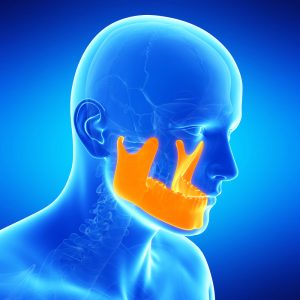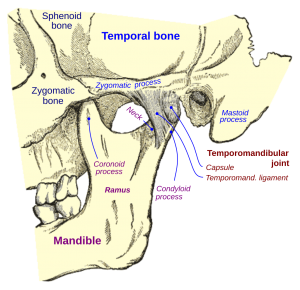- Tooth movement after braces is caused by destructive grinding.
- Braces/Invisalign are not treatment for moderate/severe Jaw Joint Damage
- TMD damage requires stability before orthodontist can position teeth
- Ortho Retainers resist mild-moderate grind-clench, but destructive grinders need Orthotic
Orthodontics refers to brackets, braces, Invisalgn, and or orthognathic surgery to reposition teeth to be in harmony –function--esthetics with “all” oral structures.
If braces are implemented on mod to sev TMD case, the jaw joint pain increases and may even displace disc causing restricted opening (complete displace disc).
Before Braces Considered:
- Jaw joint stability
- Destructive bruxism
- Small air pipe
Braces Contraindicated:
- Restricted Opening
A) Complete Displaced Disc
B) Osteoarthritis - Destructive grind-clench
- Restricted opening
- Bite changes/facial asymmetry
Jaw Joint Stability BEFORE BRACES
- Damage level
- Grinding level
- Airway deficiencies
- Bite instability
Orthodontist should insure TMD stability before braces when there is need for:
- Recapture/Stabilize Disc
- Stabilize Bone loss TMD
A referral to Orofacial Pain by orthodontist is best care for patient to achieve healing for completely displace disc and osteoarthritis of TMD.
Unstable TMD: what look for ?
- Teeth: sensitive, discomfort, pain, move, or wear
- Joint: click, pop, deflection, deviation, limited opening, loss bone, effusion
- Muscles: tight-stiff-sore, spasm, trigger points, enlargement, pain
- Ligament: stretch, tear, displace, inflamed
- Disc: partial displaced, complete displaced, retrodiscal preformation, OA
Orthotic is the best retainer for TMD cases after braces
- In TMD locking & pain, an orthotic is the retainer of choice
- Orthotic is a retainer w/ special powers:
- reduces clench-grind
- protects joint muscle
- protects teeth
- prevents muscle joint damage
- Orthotic is retainer for complete displaced disc or osteoarthritis
Destructive Parafunction
- Destroys beauty & alignment
- Reduce destructive force before alignment
- Forces teeth to move out alignment
- Retainers resist mild to moderate forces
- Destructive grind-clench moves teeth even with retainers
Specialty trained on all 11 tools reduce destructive forces of grind-clench ?
OROFACIAL PAIN SPECIALTY
Airway Evaluation before braces
- Airway borders (walls)
a) Lower: Arch vs Tongue Volume
b) Sides: Medial Pterygoid-Tonsils-Fat-connective tissue
c) Upper: palatal extension - Analysis:
a) level palatal extension into airway
b) enlarged Medial Pterygoid (extension into airway)
c) tongue volume vs arch/palate volume
Tomorrow braces will evaluate airway before pulling teeth & shrinkage arch
Braces of tomorrow will incorporate growth and development into the positioning the teeth by natural forces, not just on braces (man made mechanically forces) ?
Jaw pain during braces (activation hidden TMD)
a) Delay activation brackets or next Invisalign tray
b) Refer orofacial pain to manage jaw pain or locking
c) Chewing system orthopedic program implement
d) Create healing in joints & muscles
e) Reactivate braces and continue alignment
f) Orthotic used as retainer
Misconceptions braces & TMD ?
- Do braces-Invisalign cause jaw joint damage? NO
- Can braces set off hidden moderate damage TMD? YES
- Can braces work on mild jaw joint damage case? YES
- Braces can be effective after TMD has healed? YES
- Can braces cause flare in hidden TMD? YES
- Does bite -occlusion-interferences cause TMD ? NO
If tooth alignment is off and jaw joint damage present, what is treated first?
Jaw joint stability is required before any orthodontic treatment.
What kind cases need TMD tx before ortho?
Osteoarthritis
Restricted opening
Destructive parafunction
Atypical Toothache
Complete displaced disc
Facial asymmetry/bite changes
Dual bites, multiple bites
Atypical ear ache
Why Bite changes are concern for ortho?
- Chew system functions as 3-legged stool
- 2 back legs are jaw joints, arch of teeth is front leg
- Change in one of the back legs causes changes bite
- Two forms changes back leg (TMD)
a) Sudden loss disc
b) Bone loss in TMD - Orofacial pain specialist
a) Recapture Complete disc displacement
b) Stabilize bone turn over
Recapture disc is possible only if:
- Referral is priority by patient & orthodontist
- Disc displacement is limited period time
- Disc is still correct shape (biconcave)
- Ligaments are overstretch not all torn
- CSO team works to acquire maximum healing
Braces & Destructive Bruxism
- 3 levels:
Mild
Moderate
Destructive - Destructive Parafunction causes orthodontic failures
- Gain control over destructive bruxism before braces
- Protect position teeth & resist tooth movement by orthotic
- How does Grinding & clenching supersede retainers
a) Power night increase 6 times chewing power
b) Retainers resist only mild to moderate forces - Orthodontic Retainers woefully inadequate destructive parafunction
- OFPS has 11 tools reduce destructive bruxism.
- If all 4 areas of destruction are evident Orofacial Pain before braces
Is orthodontics necessary after chewing system orthopedics?
Yes, if bite is WAY OFF, occlusion is terrible, teeth are in wrong place
Parting Thoughts
Don’t be hurry to have straight teeth.
If the jaw joint is unstable or destructive grind is present
The beauty will not last long.
Repeating braces to restraighten teeth is futile.
The source of force to must be revealed and managed.



